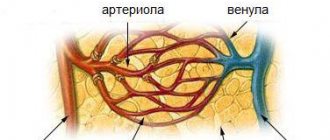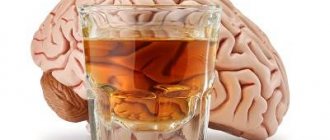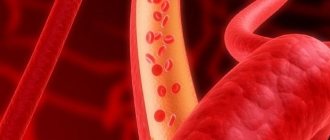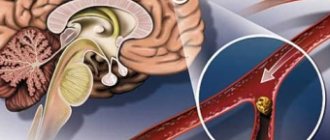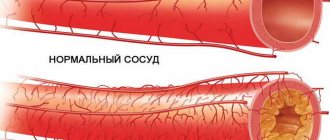Home page / Diets / Therapeutic diets / Basics and principles of diet for vascular atherosclerosis
The main component in obliterating atherosclerosis, atherosclerosis of the arteries, legs and brain, disruption of the brachiocephalic arteries is PP. A diet for atherosclerosis restores the body after the main treatment, and also prevents the occurrence of possible consequences. As many years of practice and patient reviews show, nutrition correction is the first path to healing.
Diet for vascular atherosclerosis
Why is a proper diet important for atherosclerosis?
The emergence and development of atherosclerosis occurs as a result of the accumulation of fatty deposits due to metabolic disorders and disruptions in metabolic processes.
Such stagnation of fat mass is associated with poor nutrition and excessive consumption of foods high in cholesterol. Exceeding its concentration in the body leads to vasoconstriction and poor circulation, which can subsequently lead to severe complications and death.
Since atherosclerosis develops gradually and slowly, it is possible to stop its progression with the help of a special diet combined with moderate physical activity.
REFERENCE!
It is especially important to pay attention to the treatment of the disease and the prevention of its consequences for people suffering from obesity and diseases of the cardiovascular system. These categories of people are more at risk of negative consequences than others, since the existing amount of fat deposits accelerates the development of atherosclerosis.
Dietary nutrition with restrictions on the consumption of fatty foods and dishes helps reduce cholesterol levels, improve overall health and have a positive effect on the treatment of concomitant diseases of the heart and blood vessels, and is also an effective prevention of diabetes mellitus.
Features of nutrition of patients with atherosclerotic lesions of the vessels of the neck
Most people suffer from a number of diseases for simple reasons: unhealthy lifestyle and poor diet. Atherosclerosis of the neck vessels is one such disease. The name of the disease comes from two Greek words: atheros - fat and sclerosis - to close. Already knowing this, you can understand how important diet is when treatment of this disease with medications and folk remedies is prescribed.
The causes of atherosclerosis are quite varied. Symptoms of the disease develop from a combination of several factors. These include genetic predisposition, lifestyle errors, concomitant diseases, and features of nervous regulation. But regardless of the main reason that led to the appearance of signs of damage to the vascular bed of the cervical spine, diet for atherosclerosis of the vessels of the neck is one of the most important components of treatment.
There are many large and small arteries in the human body. The peculiarity of the blood supply is such that tissue saturation
and oxygen supply to organs occurs precisely through these vessels. Arterial blood is rich in oxygen and nutrients necessary for human growth, development and functioning. The content of beneficial compounds, vitamins, fats, carbohydrates and proteins in the diet determines how varied the patient's diet is.
The vascular wall in a normal, healthy state is elastic and responds well to influences that cause spasm or, conversely, relaxation. Atherosclerotic damage to the arteries means the germination of their walls by fatty deposits, a decrease in their elasticity and the actual narrowing of the vessels through which blood moves. Atherosclerosis of the neck vessels leads to a deterioration in arterial flow to the head, brain, and cervical spine.
The reasons for the appearance of atherosclerotic changes in the vascular wall are varied, but, as a rule, they accompany one another:
- genetic predisposition;
- features of nervous regulation of hereditary and acquired nature;
- wrong diet;
- accompanying illnesses.
The combination of several factors leads to the appearance first of anatomical signs and then of symptoms of atherosclerotic damage to the vessel wall:
- headache;
- cognitive disorders;
- deterioration of memory, sleep;
- decreased emotional status;
- soreness in some areas of the neck.
These symptoms can be combined in different ways and occur in any order and pace. In addition to diet, you can use folk remedies to prevent the occurrence of vascular disease.
Genetic predisposition
Some researchers argue that the first signs of arterial atherosclerosis may appear in childhood. This confirms the theory of a hereditary mechanism in the occurrence of atherosclerotic changes. Already in childhood, such children begin to develop areas of damage to the vascular endothelium. Fat carried by the blood is deposited on these
areas in micro quantities, plaques form. Certain sections of the arteries lose their elasticity, the vessels of the head are especially susceptible to this.
The process is quite slow. A full-fledged plaque can form, which will lead to a significant narrowing of the lumen of the arteries or its part, in several years or decades. It all depends on the diet and life of such a person.
Features of diet for atherosclerosis
The main goal and feature of dietary nutrition during the developing atherosclerotic process is to reduce the cholesterol content in the daily diet in order to minimize its entry into the body. It is also important to remember that atherosclerosis occurs in most cases in people who are overweight, so it is necessary to take into account the caloric content of food consumed. Proper nutrition requires excluding fatty and high-calorie foods from the patient’s menu.
The diet should be low-carbohydrate, but not make a person starve and need food, so you need to replenish your daily calorie intake by consuming healthy foods. Thus, the following products must be included in the diet of a patient with atherosclerosis:
- vegetable oils (1–2 to choose from);
- fatty sea fish (tuna, mackerel, salmon, sardine);
- seafood (mussels, oysters);
- whole grain products;
- bran;
- low-fat meat and fish dishes;
- vegetables and herbs;
- fruits and berries;
- legumes
These products are low-calorie, but can replenish the necessary reserves of fats, proteins, carbohydrates and vitamins. Diet therapy is also necessary to increase the effectiveness of treatment. Recommendations must be followed, including:
- weight control and maintenance;
- to give up smoking;
- mandatory regular physical activity;
- limited alcohol consumption;
- reducing the amount of salt consumed in food.
Compliance with these requirements helps maintain the functioning of the heart muscle and prevent diseases. Also, in the presence of heart pathologies and hypertension, it is recommended to supplement the dietary menu with nutritional supplements and vitamin complexes to restore the body and improve immunity.
Depending on the location of the development of atherosclerosis, dietary features may differ, which are important to consider before starting therapy.
Lower limbs
Atherosclerosis of the lower extremities is characterized by disorders in the circulatory system, causing pain and heaviness in the legs. The disease provokes oxygen starvation of the limbs, which can cause trophic ulcers and gangrene. It is possible to prevent the progression of the disease by changing the patient’s menu.
Diet for the development of vascular atherosclerosis of the lower extremities requires, in addition to dietary correction, compliance with the following rules:
- mandatory cessation of bad habits, in particular smoking;
- treatment of concomitant diseases, if any, especially diseases of the muscles and joints of the legs;
- restriction of stay in lying and sitting positions;
- monitoring blood pressure, cholesterol and blood glucose levels.
IMPORTANT!
With the development of atherosclerotic leg disease, it is important to limit portions to the required minimum, especially for people who are overweight. An increase in body weight with atherosclerosis of the lower extremities can lead to difficulty walking and fatigue, which will complicate the patient’s life.
Changing your diet requires consuming foods that have a beneficial effect on the body and help prevent and treat atherosclerotic plaques that appear on the walls of blood vessels in the extremities. The daily menu should include:
- vegetable oil and fish dishes with vitamin F;
- dishes made from soybeans, beans;
- wheat bread (in small quantities);
- foods high in pectin (fruits, vegetables, bran);
- raw white cabbage;
- boiled corn.
The action of the substances included in these products in the body is aimed at lowering cholesterol levels and improving blood composition, which promotes the absorption of proteins.
It is worth remembering that treatment of atherosclerosis of the extremities must be combined with physical activity, paying special attention to walking, running (depending on the state of health) and other exercises and activities that involve the muscles of the legs.
How to eat properly?
If you have been diagnosed with vascular atherosclerosis, here are the foods that should be excluded:
Flour products made from white flour. This includes all buns, breads, and pastries. Easily digestible carbohydrates increase blood sugar levels, which increases blood hematocrit (thickness), aggravating the course of the disease and increasing the chance of blood clot formation.
- Sugar and products that contain it. Sweet fruits, honey, juices, jams, etc. They will also increase glucose in the blood, and also cause a blow to the pancreas.
Starch. In addition to baked goods and some dairy products (not to be confused with milk), it is found in potatoes, tomatoes, and corn. It is also a fast carbohydrate.
- Margarine and other trans fats. Mayonnaise, sauces, ice cream, candies and sweets. All these products contain synthetic fats that disrupt metabolism.
- Soy. The benefits of these products are questionable and not supported by consumer experience and scientific research.
Recommended Products:
- First of all, this fats. Natural animal and vegetable fats are involved in metabolism and are used by our body as raw materials for the production of hormones, enzymes, and new cell membranes. They do not affect cholesterol levels, but are only raw materials for its production.
Excluding fat leads to disruption of all body systems, problems with immunity, and general deterioration of health.An excellent choice would be:
- flax oil or olive oil;
seeds;
- nuts;
- poppy;
- coconut.
Among animal fats:
- salo;
- natural butter;
- cream.
Everything is good in moderation, including fat consumption.
- poultry and animal meat;
Restricted products:
- Salt and seasonings.
- Sweet berries (currants, raspberries) and non-green vegetables (eggplant, carrots).
- Slow carbohydrates (cereals, porridge, pasta).
Diets for lowering cholesterol levels in atherosclerosis imply a properly balanced diet to normalize the functioning of the liver, kidneys, and gastrointestinal tract. The diet given below is absolutely ineffective, since it does not help make the patient’s life easier, but it does not cause harm either. If a doctor advises you to do anything from the list, you should think about his competence.
In addition to nutrition, you need to know how to treat and what this disease is, as well as how to deal with the disease.
Menu for diseases of the arteries of the brain, heart, lower extremities
- Usually in this case it is recommended to exclude all animal and vegetable fats (egg yolks, fatty and fried meats, butter).
- The patient is given a diet where the share of carbohydrates is 80% of the total daily caloric intake.
- The basis of nutrition is porridge, whole grain bread, fruits (apples, pears).
- It is recommended to replace sugar with honey (which, by the way, is 80% sugar).
- The patient is also prescribed fasting days on kefir, which can harm an already weakened body.
Low-carbohydrate diet for atherosclerosis
What to do in such a situation? Is there a working power supply? Definitely yes! The ketogenic diet was developed by Canadian scientists to combat epilepsy, but has found applications in other areas. It is indicated for people who have problems:
Of cardio-vascular system.
- Excess weight.
- Hormonal imbalances.
- Problems with the thyroid or pancreas.
It involves a complete rejection of carbohydrates and a transition to fat energy supply.
This gives tangible advantages:
- Reducing body fat mass.
- Normalization of metabolism.
- General improvement in the condition of the body.
- Accelerated tissue regeneration.
- Stabilization of pressure.
- Relieving swelling.
Carbohydrates in the body retain water in the tissues. 1 gram of carbohydrates holds 4 grams of water, which causes swelling. When switching to such a diet, the body will eventually use up the fat that is deposited on the walls of blood vessels.
What are the disadvantages of this diet for atherosclerosis?
- Complicated entry procedure. The first few days there is a passive apathetic state, lack of mood, fatigue, drowsiness. After switching to another “fuel”, the body returns to normal.
- Limited number of products. Almost all prepared food that can be purchased on the street, in stores and eateries is prohibited.
Brain
Atherosclerotic cerebrovascular disease is a deadly cerebral form of pathology. This type of disease causes strokes with further death of patients. The disease can also lead to irreversible complications due to damage to the nervous system and the formation of cholesterol plaques in the brain. Such a process can lead to a cessation of blood supply to the central nervous system, leading to sudden death.
IMPORTANT!
As with other forms of atherosclerosis, the accumulation of cholesterol in the brain requires avoidance of smoking and mandatory physical activity. Patients are also advised to avoid stressful situations and strong emotional outbursts.
Proper nutrition for progressive cerebral atherosclerosis excludes the patient from consuming the following products:
- alcoholic drinks;
- chocolate and chocolate candies;
- coffee and caffeinated drinks;
- fatty varieties of sausages, in particular salami;
- whipped cream and other high-calorie dairy products;
- fish roe;
- sweets, including sugar and honey;
- all types of liver;
- fatty meats and fish.
Low-fat fish dishes are mandatory for the diet. It is recommended in most cases to replace meat products with plant foods with a similar composition. It is necessary to consume foods containing:
- fiber (potatoes, raspberries, gooseberries);
- vitamin C (currants, greens, cabbage);
- B vitamins (cereals, nuts, fruits and vegetables);
- vitamin P (tomatoes, citruses, berries);
- magnesium (avocado, beans, bran);
- potassium (pumpkin, apricots, nuts);
- calcium (sesame, greens, cheese);
- phosphorus (eggs, fish, whole grains).
ATTENTION!
It is allowed to dilute the diet with juices, decoctions and soups, as they help speed up metabolic processes in the body. All dishes must be prepared without the use of salt.
How to diversify your therapeutic diet?
At first glance, therapeutic nutrition for cerebral atherosclerosis seems rather boring and monotonous. This leads to many patients breaking their diet, unable to cope with bland food. In fact, you can and should treat yourself to something tasty. That is why it is very important to know which foods will not harm the blood vessels of the brain.
To do this, the diet includes Mediterranean dishes containing seafood. Japanese cuisine is also not a contraindication for “cores” - you just have to exclude hot sauces, and otherwise rice, fish, soy, vegetables and noodles will only benefit you. You can eat fruits, drink green tea, prepare vegetable salads and season them with soy sauce.
Muesli is a healthy and tasty food for every day; it can be made moderately sweet and “seasoned” with nuts and dried fruits. There are no strict restrictions on the consumption of pasta - you can eat it with lean fish steaks, stewed vegetables and chicken breast.
In the fight against atherosclerosis, as people say: all methods are good (folk remedies, herbs), if combined and under the supervision of a specialist.
Why sugar?
With the development of insulin resistance in blood cells, carbohydrates are not broken down into simple sugars by the hormone insulin, and they do not enter the cell, accumulating on the walls. These accumulations form the basis for plaques, which, in turn, attract both lipid and protein fractions. It is carbohydrates that form the “soil” for atherosclerosis, not fats.
Let's remember history: all our ancestors lived from hand to mouth, since food was always in short supply. It's no secret that people lived much longer back then, despite the wars and the lack of legal institutions. Hunger is a more natural state for our body than overeating.
With the development of the agricultural industry, flour products and cereals became widely available, which led to the discovery of a new disease - atherosclerosis (sclerosis). Is this a coincidence?
REFERENCE! Peoples living in cold, devoid of vegetation regions (Greenland, the North Pole) are not familiar with diseases such as atherosclerosis and diabetes, although their entire diet consists of fatty animal meat and fish.
Carotid arteries
Atherosclerosis of the carotid arteries is a serious and severe disease that requires long-term treatment and correction of the patient’s menu. The disease can lead to stroke, impaired blood supply to the brain and further death. The last stages of this type of atherosclerosis are incurable without timely surgical intervention, but the developing disease can be cured by correcting the diet.
The main and main requirement for a proper low-carbohydrate diet (“low-carbohydrate”) is the exclusion of fatty and salty foods. The patient must also follow these rules:
- stop smoking;
- control your weight and gradually reduce it to normal;
- stop eating at night (you can replace such snacks with a glass of water or one raw fruit);
- take necessary medications.
While following a diet, it is important for the patient to monitor his health status and monitor its indicators. Unlike other types of atherosclerosis, this form does not require regular heavy physical activity, but it is recommended to often be in the fresh air and go for walks.
How to restore blood vessels with exercise?
Constant physical activity is an effective method used to improve the functioning of blood vessels. When the body remains in one position for a long time, the blood flow of the whole body slows down and concentrates in the lower extremities. Systematic physical exercise will not only restore the functioning of blood vessels, but also improve the condition of the neck muscles.
With the help of exercises you can:
- restore blood pressure levels,
- expand the walls of blood vessels,
- improve blood circulation in the body.
To cure such a pathology, you need to play sports at least 3 times every fourteen days. For beginners, 15 minutes of physical therapy will be enough.
Advice! When playing sports, you must avoid overwork.
You can strengthen blood vessels through swimming, dancing, gymnastics, and running. In this case, it is worth monitoring overvoltage. To maintain blood channels in good shape, it is recommended to take a contrast shower. A weekly visit to a bathhouse or sauna can also help strengthen the walls of thin blood vessels. People with weak arteries and high blood pressure can take baths with contrasting temperatures based on herbs.
Heart vessels
Atherosclerotic processes in the area of the heart muscle often provoke the development of stroke, myocardial infarction, coronary heart disease and other diseases and pathologies of the cardiovascular system.
REFERENCE!
Proper nutrition during progressive atherosclerosis can have a positive effect on the state of the blood, reduce the risk of developing consequences and prevent the formation of atherosclerotic plaques, which stop the heart and lead to death.
The therapeutic diet is based on reducing cholesterol in the diet, as well as reducing calories by 10–15% compared to the norm. Thus, the patient is recommended to periodically arrange full fasting days with minimal food consumption in the form of fruits and kefir (cottage cheese). Nutrition for atherosclerosis of the heart vessels should be balanced and include the following products:
- all types of fish;
- meat dishes, including lean poultry;
- low-fat dairy products;
- fruits;
- vegetables;
- eggs;
- nuts, in particular walnuts and almonds;
- mild spices;
- pasta and cereal products;
- weak tea and coffee;
- bran bread;
- freshly squeezed juices without sugar.
It is also recommended to add vegetable oils, honey and marshmallows to the daily menu in small quantities. It is important that your diet includes complex carbohydrates in the form of fresh fruits and vegetables, as well as iodized foods - seafood, potatoes, herbs and cheeses. You should regularly consume plant foods with vitamin C and rutin.
Diet therapy for atherosclerosis of the heart vessels also requires physical activity and health monitoring. It is especially useful to engage in race walking and jogging, which will not only help treat the disease, but also strengthen the heart muscle. Blood cholesterol levels and glucose concentrations should be checked regularly to prevent the development of complications, including incurable diabetes mellitus.
Causes of the disease
Unfortunately, this is a serious problem of the present and past centuries. The number of patients with this disease has increased by almost 50 percent in ten years. The most common type is atherosclerosis of the aorta.
In most cases, this disease occurs in representatives of the stronger sex between the ages of 40 and 60, and in women over 52 years of age. The most common factors for the development of this disease are an unbalanced diet and a lifestyle without exercise. Metabolic disorders and excess weight also have a negative impact on health. Factors include frequent stress, smoking and high blood pressure. Initial symptoms of the disease: pain in the heart, in the chest, discomfort when breathing, less often - pain in the back, nausea and vomiting, weakness of the legs.
According to disappointing statistics, every third person on the planet dies from this disease. Moreover, approximately 28 percent of the total number are people aged 18 to 20 years. To alleviate the symptoms of the disease and improve the condition of the body, a patient suffering from such an illness resorts to a diet for vascular atherosclerosis. But before that, be sure to see a doctor.
Basic principles of nutrition
The basic principles of dietary nutrition for atherosclerosis, regardless of its stage and location, include the following:
- Reducing the energy value of the daily diet to 2200–2600 kilocalories, limiting simple carbohydrates to restore normal body weight.
- Limiting the consumption of fried foods, removing excess fat from cooked meat.
- Increasing protein in the diet through the consumption of lean meats, fish and dairy products, which increases energy costs for digesting food and prolongs the feeling of fullness.
- Minimizing salt intake to 5–7 grams per day.
- Mandatory daily consumption of foods with the necessary content of vitamins, minerals and other beneficial microelements.
- Regular monitoring of cholesterol levels in the body and weight.
- Eat small meals 4 to 6 times a day.
- No snacking or long breaks between meals.
- Maintaining a drinking regime, in which it is necessary to drink at least 1 and no more than 1.5 liters of liquid per day.
- Replacing fried and smoked dishes with boiled and stewed ones.
It is important to maintain a balanced diet by consuming the following components:
- Oils and “good” fats - to maintain the balance of lipids in the blood (vegetable oils, seafood).
- Complex carbohydrates, which should make up at least 50% of all food consumed (fruits and vegetables).
- Fiber - to protect the heart and blood vessels, muffle the feeling of hunger (pasta, potatoes, cereals).
- Protein - to maintain healthy muscles and bones (meat, fish, soy).
- Vitamins and antioxidants - to protect the circulatory system and improve immunity (fruits, vegetables, meat).
- Potassium and calcium - to normalize blood pressure (prunes, bananas, pears, nuts, avocados).
ATTENTION!
Dietary meals and a full menu for the week must include all these components for effective treatment.
Dish recipes
The main dishes for dietary nutrition for atherosclerosis are prepared from meat and fish. The remaining permitted products do not require special preparation methods according to recipes. Thus, vegetables and fruits can be consumed raw, baked or stewed with the addition of vegetable oil and spices. Pasta and cereal products should be boiled.
Among the recipes for meat and fish dishes, the most nutritious and healthy are:
- Meat with prunes. To prepare, you need 700 g of lean meat and 2 onions, thinly cut into strips and fry in oil. Then sprinkle the meat with flour and fill the bottom of the pan with water, then bring the dish to readiness over low heat. At the end, you need to add 50-100 g of pre-soaked pitted prunes.
- Fish meatballs. To prepare, you need to mix 400 g of minced fish (low-fat) with 2 tbsp. l. cooked rice and 1 chopped onion. Then beat 1 egg into the minced meat, mix everything and roll into balls. Sprinkle the meatballs with flour and fry in vegetable oil for 1–2 minutes, then pour them with a mixture of low-fat sour cream and water (100 g) and simmer for 20 minutes.
- Baked fish with mashed potatoes. To prepare, prepare boiled puree from 1 small potato, mix it with 120 g of minced fish fillet and 40 g of soaked mashed bread. To the mixture you need to add 0.5 eggs, 1 tsp. milk, then mix everything, form into a casserole and bake in the oven.
ATTENTION!
It is forbidden to add salt during the cooking process; you can only add salt to the finished dish.
What is forbidden to eat if you have atherosclerosis?
Depending on the type and form of manifestation of atherosclerosis, the list of prohibited products may increase. But regardless of the location of the disease, it is necessary to exclude from the daily menu:
- baked goods and flour products;
- sweets and sugar;
- sauces and mayonnaise;
- smoked dishes (meat, cheese, fish);
- sausages;
- strong alcoholic drinks;
- tobacco and nicotine-containing substances;
- red meat;
- fatty fish;
- canned fish and caviar;
- fruits high in sugar;
- carbonated drinks;
- store-bought juices;
- soups with mushrooms, legumes and fatty broths;
- strong tea and coffee drinks;
- margarine and spreads;
- salo;
- liver and pates;
- offal;
- fatty dairy products (cream, homemade milk, fatty cheeses, sour cream);
- fast food.
ATTENTION!
You should not risk your health and ignore this list of exceptions, since frequent consumption of these dishes and products accelerates the development of atherosclerosis and reduces the risk of recovery.
Strengthening arteries with medications
It is also possible to restore the functioning of cerebral vessels with the help of medications. Correct and timely administration of medications can quickly improve blood flow in the arteries, concentration, memory, and attention.
The main drugs for normalizing blood flow and elasticity of blood vessels are Edas 138 and Cerebralic. The first version of the medicine is presented in the form of drops. This is an alcohol tincture, which is made on the basis of Arnica, Mistletoe, Sporynbia. Edas 138 can be taken both for circulatory disorders and for VSD. Cerebralic are vascular-strengthening drops that can be purchased in pharmacies at an affordable price. This drug is often prescribed for the treatment of cerebral atherosclerosis and Parkinson's disease. Depending on the condition of the blood vessels, the doctor may also prescribe tablets.
Sclerovish drops are no less effective. A tincture is made based on herbs that help quickly restore blood circulation to the brain. Instructions for use and reviews of Sklerovish can be read on the Internet.
What is not advisable to consume?
In addition to prohibited foods, there is a list of foods that are allowed only in minimal quantities. It can be consumed if all dietary rules are observed, as well as in the absence of concomitant diseases. Such products include:
- honey;
- cheese up to 30% fat;
- soy sauce;
- dry red wine;
- malt whiskey;
- chicken eggs;
- butter;
- semolina and rice porridge;
- weak coffee;
- Black tea.
The limitation of these types of food depends on the frequency of their consumption and quantity. It is not recommended to include them in the menu more than once a week.
Sample menu for the week
The weekly menu for developing atherosclerosis should be balanced and complete. So, on Monday it is recommended to eat:
- 1st meal - oatmeal, vegetable salad and weak coffee;
- 2nd - boiled meat, 1 fresh fruit and a portion of cottage cheese;
- 3rd - cabbage soup, stewed potatoes with meat, dried fruit broth;
- 4th - 1 glass of kefir;
- 5th - baked fish fillet, boiled potatoes, 1 fresh fruit and weak tea.
On Tuesday you can include in your diet:
- 1st meal - omelet, millet porridge and a glass of chicory drink;
- 2nd - vegetable salad;
- 3rd - vegetable soup, steamed chicken cutlets, berry broth;
- 4th - a portion of cottage cheese and 1 orange;
- 5th - pumpkin porridge and boiled fish.
On Wednesday, the menu is recommended to be composed as follows:
- 1st meal - a portion of cottage cheese, 1 apple and 1 glass of tea;
- 2nd - cottage cheese casserole;
- 3rd - rice soup, fish meatballs, seafood salad, fruit broth;
- 4th - 1 glass of low-fat milk;
- 5th - boiled fish, mashed potatoes, vegetable salad with vegetable oil and 1 glass of tea.
On Thursday you can use the following menu:
- 1st meal - pearl barley porridge, 1 fresh vegetable and a glass of weak tea;
- 2nd - sandwich with cheese and 1 glass of chicory;
- 3rd - low-fat borscht, steamed fish cutlets, 1 fresh vegetable, berry broth;
- 4th - a portion of cottage cheese;
- 5th - pilaf, cabbage salad and 1 glass of kefir.
On Friday, the diet may include the following foods:
- 1st meal - 1 banana and 1 glass of weak coffee;
- 2nd - low-fat yogurt and 1 apple;
- 3rd - vegetable broth, seaweed salad, boiled beets and dried fruit broth;
- 4th - 1 glass of tea and dry cookies;
- 5th - baked fish, vegetable salad, 1 glass of weak tea.
On Saturday, the following diet is recommended:
- 1st meal - oatmeal and weak tea;
- 2nd - a sandwich with ham and a glass of kefir;
- 3rd - beetroot soup, steamed cutlets, vegetable salad and fruit broth;
- 4th - 1 glass of kefir;
- 5th - fish balls, cabbage salad, 1 fruit and 1 glass of tea.
On Sunday you can eat:
- 1st meal - cottage cheese casserole, 1 banana and 1 glass of chicory;
- 2nd - 1 glass of low-fat yogurt;
- 3rd - low-fat chicken broth, pasta, steam cutlets, dried fruit broth;
- 4th - a portion of cottage cheese;
- 5th - boiled potatoes, fish cutlets, cucumber salad and 1 glass of tea.
It is recommended to supplement any meal with 1-2 slices of bran bread.
When creating a menu, it is important to take into account the calorie and fat content of foods, distribute portions and meals. In total, the norm of consumed products should not exceed 250–300 grams in the morning and lunchtime and 150–200 grams in the evening.



